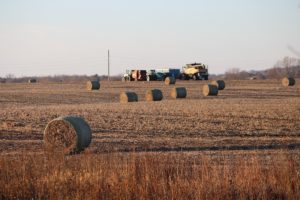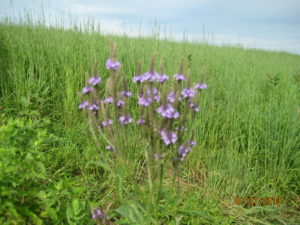Below the Surface
 Iowa is synonymous with agriculture. Our state is renowned for its rich soil, and its farmers often claim that they “feed the world.” The landscape is largely vistas of corn and soybeans in the warmer seasons, swathes of bare stubble over the winter, pocked with towns and cities scattered along rivers and other areas favorable to human populations.
Iowa is synonymous with agriculture. Our state is renowned for its rich soil, and its farmers often claim that they “feed the world.” The landscape is largely vistas of corn and soybeans in the warmer seasons, swathes of bare stubble over the winter, pocked with towns and cities scattered along rivers and other areas favorable to human populations.
This soil, the source of generations of wealth and well-being, is a legacy of the prairies that once covered this land. Deep-rooted prairie plants grew, died, and decomposed for millennia, building up many inches of nutrient-rich earth held in place by those long, spreading roots. Rainfall could infiltrate the land, penetrating the surface and sinking below to water the grasses and forbs that grew.
Over time, those prairies were plowed under and replaced with crops. In recent decades, the crops became largely huge monocultures of corn and soybeans. Gone was the diversity of plant, animal, and insect species that once reigned. The rich soil, no longer held in place by those deep-rooted prairie plants, washed away in heavy rains, clogging rivers and carrying fertilizer and pesticides with it. Rivers, lakes, and other waterways become impaired by the runoff, requiring treatment before it can be used for all the necessities that water is used for.
Even as the prairies gave way to farmland, farmland gives way to concrete. Expanding towns replace corn fields with houses and roads, scraping away or covering over what is left of that rich soil millennia in the making. How we take for granted that rich heritage of the prairies, and how easily we watch it go to waste.
Think about the earth under a prairie, or beneath a wooded ravine. Stretching roots; burrowing mammals; digging worms and insects. The sun warms the surface while rain and snow deliver moisture at intervals. Seeds dropped by passing birds or blown by a strong breeze find purchase and grow into new generations, providing food and habitat for many other species beyond their own.
Now think about the earth under a field of corn. Shallow roots, unwilling to share the earth with other species–plant, insect, or otherwise. It does not thrive on the meager bounty of sun and rain that sustained life for thousands of years before the arrival of monoculture but instead relies on inputs of fertilizer to fuel growth and pesticides to keep out any unwanted life.
And then–imagine the earth under a parking lot, or a paved road. No water can reach it; the sun bakes the artificial surface but gives no life. The only roots are those that stretch sideways from the nearest open patch of land hospitable to plant life. Does anything live below that surface?
The soil made Iowa what it is today. The prairies made that soil. As we consider how our state has changed over the past couple of centuries, and how it will continue to change, we should always be mindful of whence our state’s greatest wealth came. How long it took to develop, and how quickly we have lost so much of it.
 Let’s imagine what we could do to begin to build and restore even small parts of the land and preserve its life-giving functions. Make sure that every acre paved and every foundation laid is absolutely necessary, because it is far too easy to destroy the work of generations for a short-term profit.
Let’s imagine what we could do to begin to build and restore even small parts of the land and preserve its life-giving functions. Make sure that every acre paved and every foundation laid is absolutely necessary, because it is far too easy to destroy the work of generations for a short-term profit.
Organizations working to preserve our state’s natural heritage:
Bur Oak Land Trust: protecting natural areas to enrich and engage current and future generations.
Sustainable Iowa Land Trust: dedicated to preserving land for sustainable agriculture.
Iowa Natural Heritage Foundation: helping to protect and restore Iowa’s land, water, and wildlife.
Nature Conservancy in Iowa: working to preserve our state’s natural landscapes.
Originally published in Sycamore Greenway Friends.


